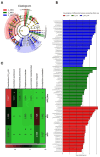Nutraceutical supplement slim reshaped colon histomorphology and reduces Mucispirillum schaedleri in obese mice
- PMID: 40236479
- PMCID: PMC11997693
- DOI: 10.3389/fmicb.2025.1494994
Nutraceutical supplement slim reshaped colon histomorphology and reduces Mucispirillum schaedleri in obese mice
Abstract
Introduction: Bioactive compounds and whole foods have emerged as promising interventions to address gut microbiota dysbiosis linked to obesity. Compounds such as berberine and coenzyme Q10 are well-recognized for their roles in managing metabolic syndrome and exerting antioxidant effects, while beet pulp, rich in fiber and antioxidants, enhances gut health through additional prebiotic benefits.
Methods: This study evaluated the effects of a nutraceutical supplement, Slim, on the modulation of gut microbiota in obese mice induced by a high-fat diet.
Results: Our results demonstrated that Slim supplementation significantly improved lipid metabolism, reshaped colon histomorphology, and decreased levels of Mucispirillum schaedleri, which were correlated with VLDL-c and triglycerides.
Discussion: We suggest these effects are driven by a duplibiotic effect, resulting from the synergistic action of the bioactive compounds.
Keywords: beet pulp; berberine; coenzyme q10; gut microbiota; nutraceutical; obesity; prebiotic.
Copyright © 2025 Freitas, Nehmi Filho, Santamarina, Murata, Franco, Fonseca, Martins, Souza, Benicio, Sabbag, de Souza, Otoch and Pessoa.
Conflict of interest statement
VN and JO are part of the Company Efeom Nutrition S.A as partners who may benefit in some way from revenues or financial losses with the publication of this manuscript, now or in the future. JAF, AS, ES, and AP received salaries from Efeom Nutrition S.A. VN, JO, and AP hold patents related to the content of the manuscript. The remaining authors declare that the research was conducted in the absence of any commercial or financial relationships that could be construed as a potential conflict of interest.
Figures








Similar articles
-
Gut microbiota-directed intervention with high-amylose maize ameliorates metabolic dysfunction in diet-induced obese mice.Food Funct. 2022 Sep 22;13(18):9481-9495. doi: 10.1039/d2fo01211a. Food Funct. 2022. PMID: 35993118
-
Pomegranate fruit pulp polyphenols reduce diet-induced obesity with modulation of gut microbiota in mice.J Sci Food Agric. 2022 Mar 30;102(5):1968-1977. doi: 10.1002/jsfa.11535. Epub 2021 Sep 24. J Sci Food Agric. 2022. PMID: 34514612
-
Ramulus mori (Sangzhi) alkaloids regulates gut microbiota disorder and its metabolism profiles in obese mice induced by a high-fat diet.Front Pharmacol. 2023 Mar 31;14:1166635. doi: 10.3389/fphar.2023.1166635. eCollection 2023. Front Pharmacol. 2023. PMID: 37063280 Free PMC article.
-
Prebiotic effects: metabolic and health benefits.Br J Nutr. 2010 Aug;104 Suppl 2:S1-63. doi: 10.1017/S0007114510003363. Br J Nutr. 2010. PMID: 20920376 Review.
-
A review on bioactive compounds of beet (Beta vulgaris L. subsp. vulgaris) with special emphasis on their beneficial effects on gut microbiota and gastrointestinal health.Crit Rev Food Sci Nutr. 2021;61(12):2022-2033. doi: 10.1080/10408398.2020.1768510. Epub 2020 May 25. Crit Rev Food Sci Nutr. 2021. PMID: 32449379 Review.
References
-
- Andrade E., Lima A., Nunes I., Orlando D., Gondim P., Zangeronimo M., et al. . (2016). Exercise and Beta-glucan consumption (Saccharomyces cerevisiae) improve the metabolic profile and reduce the Atherogenic index in type 2 diabetic rats (HFD/STZ). Nutrients 8:792. doi: 10.3390/nu8120792, PMID: - DOI - PMC - PubMed
-
- ANVISA (2018). INSTRUÇÃO NORMATIVA - IN No 28, DE 26 DE JULHO DE 2018. Ministério da Saúde - MS, 1–48. Available online at: https://antigo.anvisa.gov.br/documents/10181/3898888/IN_28_2018_COMP.pdf...
LinkOut - more resources
Full Text Sources
Research Materials

